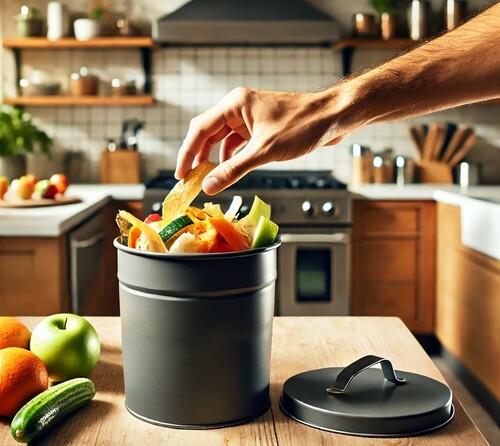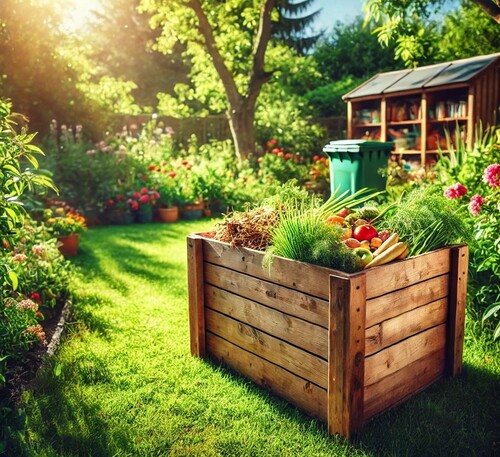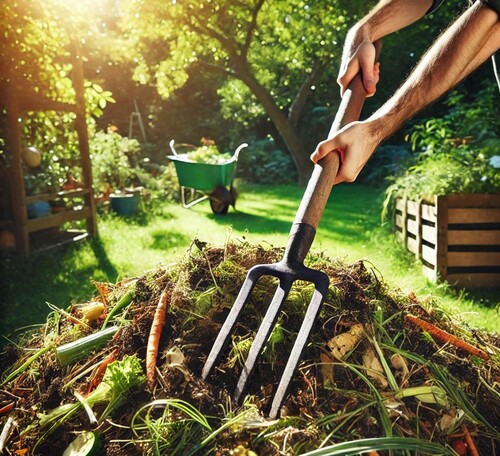The Complete Guide to Seasonal Composting: Year-Round Success
Introduction
Seasonal composting requires adapting your practices as the weather changes throughout the year. Your compost pile’s performance varies significantly with temperature fluctuations—slowing in winter and accelerating in summer. Each season presents unique challenges and opportunities for composting success, making it essential to understand and work with nature’s cycles.
The composting process naturally shifts pace with temperature changes, and different organic materials become available as the seasons progress. These seasonal variations affect everything from decomposition rates to moisture management. By making thoughtful adjustments to your composting routine, you can maintain an active pile year-round and achieve these key benefits:
- Maintain consistent decomposition despite weather changes
- Produce higher-quality compost throughout the year
- Avoid common seasonal pitfalls that can halt the process
- Maximize the use of seasonally available materials
- Create a sustainable year-round waste management system
The secret to successful composting lies in working with nature’s cycles rather than against them. Understanding how environmental factors influence the composting process allows you to adapt your methods effectively and maintain optimal conditions regardless of the season.
Composting in Winter

A Snow-covered Wooden Compost Bin in Winter
Winter presents unique challenges for composting, but with the right techniques, you can keep your pile active despite the cold. The main objectives during winter months are maintaining sufficient heat for decomposition, protecting your pile from excess moisture, and continuing to add materials despite cold temperatures.
Keeping Compost Active
Cold weather doesn’t have to halt your composting efforts. Proper insulation and strategic placement become crucial factors in maintaining an active composting process throughout the winter months. Here’s how to optimize your winter composting:
Insulation Techniques
Proper insulation is crucial for winter composting success . Create a protective barrier around your pile by layering the outer edges with six inches of straw or fallen leaves. This natural insulation helps maintain a stable internal temperature, which is essential for microbial activity.
Advanced winter insulation strategies:
1. Use a double-walled bin for extra protection:
- Add foam insulation between walls
- Seal gaps and cracks
- Maintain air circulation vents
2. Surround your existing bin with hay bales:
- Stack bales tightly against all sides
- Create a windbreak wall on the north side
- Leave the top accessible for adding materials
3. Cover strategically with black plastic:
- Secure edges to prevent wind lift
- Create a slight slope for water runoff
- Remove during sunny days to absorb heat
Strategic Winter Placement
The location of your compost pile becomes particularly important during winter months. For optimal winter performance:
Ideal placement characteristics:
- Against south-facing walls for thermal benefits
- Protected from prevailing winds by structures or barriers
- Accessible even in heavy snow conditions
- Slight slope for drainage
- Close to kitchen door for convenience
Common winter placement solutions:
1. Create temporary windbreaks using:
- Straw bales
- Plywood barriers
- Snow walls
- Dense evergreen branches
2. Establish ground protection:
- Elevate bins or pallets
- Use a gravel base for drainage
- Install plastic sheeting underneath
- Create water diversion channels
What to Compost in Winter

Eco-Friendly Kitchen Composting: Add Your Food Scraps to Reduce Waste
Suitable Materials
Winter composting success relies heavily on using the right ingredients in the right proportions. Focus on materials that generate heat and maintain proper moisture levels.
High-value winter materials:
- Coffee grounds (nitrogen rich and heat generating)
- Kitchen scraps (consistent source of green materials)
- Shredded paper (moisture control and carbon source)
- Wood ash (in moderation for mineral content)
- Sawdust (excellent insulator when used correctly)
Material preparation tips:
- Chop kitchen scraps into smaller pieces for faster decomposition
- Store autumn leaves in dry areas for winter carbon needs
- Collect coffee grounds from local cafés weekly
- Pre-moisten dry materials before adding to pile
- Layer materials carefully to maintain proper ratios
Maintaining the Winter Pile
A well-maintained winter pile requires consistent attention and strategic management.
Weekly maintenance tasks:
- Check core temperature in multiple locations
- Add fresh materials to center only
- Monitor moisture levels
- Clear snow from access areas
- Adjust insulation as needed
Monthly maintenance procedures:
- Turn center portions gently
- Assess overall pile size
- Check for frozen sections
- Clean and organize tools
- Record temperature trends
Winter maintenance schedule:
- Early morning: Check temperatures
- Midday: Add new materials
- Evening: Secure covers and insulation
- Monthly: Evaluate pile progress
Advanced winter maintenance techniques:
- Use vertical aeration tubes for oxygen flow
- Create dedicated zones for new additions
- Maintain multiple small piles instead of one large one
- Implement a rotating schedule for pile turning
- Keep detailed records of pile performance
Summer Composting

Backyard Composting in a Wooden Bin: Sustainable Gardening in Summer
Summer’s heat accelerates decomposition but requires careful moisture management. High temperatures can quickly dry out your pile, halting the composting process.
Managing Heat and Moisture
Preventing Drying Out
Hot summer days can rapidly dehydrate your compost pile. Check moisture levels frequently and water regularly, especially during heat waves. A moisture meter can help, but the squeeze test works well too—materials should release a few drops when squeezed firmly.
Keep your pile hydrated with these techniques:
- Water deeply when needed—not just the surface
- Cover with a breathable tarp during extreme heat
- Add fresh green materials to maintain moisture
- Monitor moisture levels daily
Troubleshooting summer moisture:
Some signs of a too-dry pile are:
- Materials are dusty or brittle
- Pile isn’t heating up
- Decomposition slows significantly
Solutions:
- Water thoroughly in early morning
- Add moisture-rich green materials
- Create a shallow depression in pile top to catch rain
Advanced Summer Techniques
Optimize summer composting:
- Layer materials to prevent matting
- Use vertical aeration tubes for better airflow
- Create a “hot spot” for rapid decomposition
Some common summer problems include:
1. Odor issues, which usually indicate too many greens
- Solution: Add browns and turn the pile
2. Pest attraction:
- Solution: Use a rodent-resistant bin and bury food scraps in pile center
Shade and Location
Smart positioning helps manage summer heat:
- Move bins to partially shaded areas
- Use shade cloth for additional protection
- Ensure good air circulation around the pile
Your ideal summer setup should get morning sun and afternoon shade, protecting the pile during the hottest part of the day.
Speeding Up Decomposition

Using a Pitchfork for Proper Airflow in Your Backyard Compost Pile
Summer’s heat naturally accelerates the composting process. Work with these conditions to create compost more quickly.
Aeration Techniques
Aerating your compost pile is essential to keep it active and avoid anaerobic conditions, which can lead to bad smells and slow decomposition. The most common method is turning the pile every one to two weeks.
Simple aeration techniques:
- Turn the pile regularly: This introduces oxygen into the mix, helping microbes break down materials more efficiently.
- Use a compost aerator tool : This tool can create air pockets without requiring a full turn of the pile.
- Add coarse materials: Items like wood chips help create natural air pockets.
Proper aeration accelerates decomposition and ensures your pile stays active year-round, especially during the hotter summer months when airflow is limited.
Material Balance
Maintaining the right balance of green and brown materials is crucial for successful composting. Aim for a 2:1 ratio of browns (carbon-rich materials like leaves and paper) to greens (nitrogen-rich materials like kitchen scraps).
Common material balance issues:
- Too many greens: This can make your pile hot or smelly. Add more browns to correct the imbalance.
- Too many browns: If decomposition slows, mix in more greens to jumpstart the process.
A well-balanced compost pile ensures efficient decomposition and prevents common problems like odor and slow breakdown.
Spring and Fall Considerations

Adding Fresh Green Materials for a Healthy Compost Pile
Spring Restart
Spring signals the time to revitalize your compost pile. As temperatures warm, microbial activity increases, making this the perfect time to kick-start your composting efforts.
Revitalizing Your Compost
Spring is also the ideal time to revive an existing compost pile. Warmer weather naturally boosts microbial activity, making it easier to refresh the pile.
Steps to revitalize your compost :
- Turn the pile: Aerate the pile to introduce oxygen and redistribute materials.
- Add new greens: Fresh kitchen scraps or grass clippings can reenergize your compost.
- Check moisture levels: Ensure the pile isn’t too dry or soggy and adjust as needed.
By revitalizing your compost in spring, you can turn garden waste into rich soil just in time for the growing season.
Starting New Piles
Spring is the perfect time to start a new compost pile. The abundance of green materials like grass clippings and garden trimmings makes it easy to get the pile going. Begin with a base of coarse materials for aeration and drainage, and then alternate layers of green and brown materials for balance.
Key spring composting tips:
- Use garden trimmings and kitchen scraps as greens: These materials provide nitrogen for fast decomposition.
- Add leftover fall leaves: They serve as browns to balance the fresh greens.
- Turn the pile regularly: Frequent turning helps speed up the composting process.
Starting a fresh pile in spring gives you the chance to take full advantage of the season’s organic waste while preparing nutrient-rich compost for your garden.
Fall Preparation
Fall is the ideal time to prepare for successful winter composting. Take advantage of abundant materials to set yourself up for year-round success.
Stockpiling Brown Materials
Stockpiling brown materials is essential for maintaining a balanced compost pile, especially during winter. Carbon-rich materials like dried leaves and straw are in short supply during the colder months, so it’s important to gather them in the fall when they are abundant.
Effective storage tips:
- Collect and bag autumn leaves: Store them in a dry location for use throughout the winter.
- Shred materials for better storage: Shredded leaves and cardboard take up less space and decompose faster when added to your pile.
- Balance your pile year-round: Brown materials help offset the nitrogen-rich kitchen scraps you’ll have plenty of in the winter.
By stockpiling these materials, you’ll ensure your compost stays healthy and productive even when brown resources are harder to find.
Insulating for Winter
In winter, insulation is critical to keep your compost pile from freezing and to maintain microbial activity. Start by surrounding your pile with natural insulators like straw, leaves, or old blankets. These materials will help maintain a warm core, allowing decomposition to continue despite cold temperatures.
Simple winter insulation tips:
- Layer leaves or straw around the pile: This adds a protective barrier and traps heat.
- Use a double-walled compost bin: These bins provide extra insulation, especially if you add foam between the walls.
- Strategic placement: Set up your compost pile near a south-facing wall to absorb daytime heat while protecting it from wind.
By insulating your compost properly, you’ll create an environment where decomposition can continue even in the harshest winter conditions.
Conclusion
Year-Round Composting
Successfully adapting to seasonal changes ensures continuous composting throughout the year. By understanding and working with nature’s cycles, you can maintain an active, productive compost pile in any weather. The effort you put into adjusting your practices with the seasons will reward you with a constant supply of nutrient-rich compost.
Start implementing these seasonal composting techniques today. For expert guidance on composting and sustainable landscaping practices, contact Arborist Now —our certified arborists can help you achieve your gardening goals in every season.
We may receive affiliate compensation for some of the links below at no cost to you if you decide to make a purchase.


